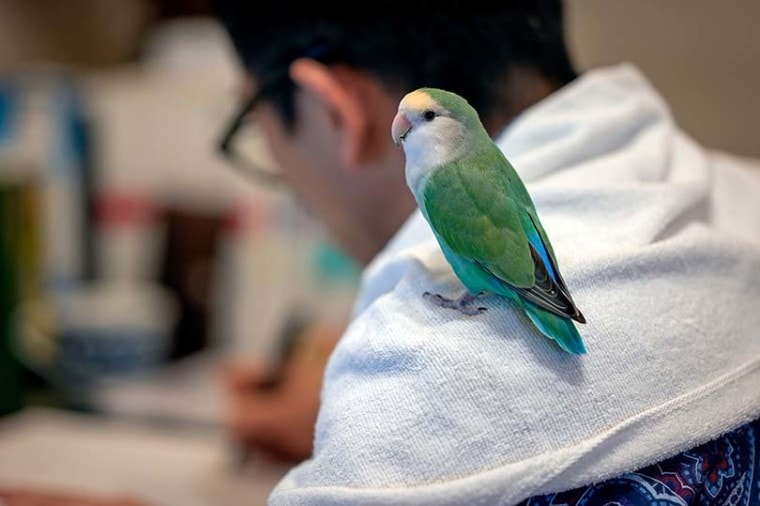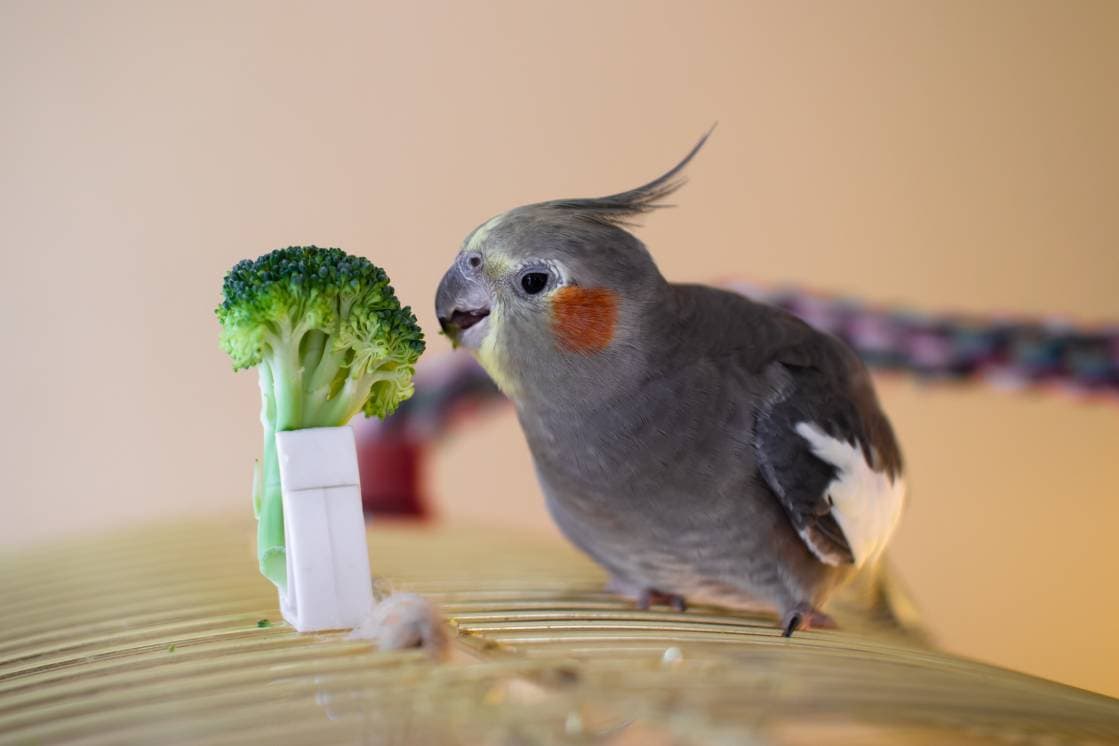
The blue peach-faced lovebird is a color mutation of the popular peach-faced lovebird. It is a popular pet bird, thanks partially to its markings and colors, but also to its playful nature. Give the peach-faced lovebird plenty of toys because it is a busy breed that enjoys being active.
The peach-faced lovebird does well when kept individually or in a pair and is known for being an affectionate little bird when hand-reared and given a lot of attention. In terms of appearance, the blue mutation differs from the standard look with fewer red and yellow feathers. Along with the white-faced blue lovebird, this is one of the most popular color mutations and is somewhat similar to the seagreen lovebird, which combines the white-faced and the blue peach-faced mutations.
Species Overview

| Common Names: | Blue rosy-faced lovebird, blue rosy-collared lovebird, blue peach-faced lovebird, Dutch blue lovebird |
| Scientific Name: | Agapornis roseicollis |
| Adult Size: | 6” |
| Life Expectancy: | 12-15 years |
Origin and History
The peach-faced lovebird comes from arid areas of southwest Africa. They can be found in Angola, Namibia, and South Africa and are usually found around water sources, where the sociable bird gathers to have a drink. In the wild, the species is not considered threatened.
This small parrot’s size makes it a popular choice of pet bird. Its amicable nature and friendly tendencies have seen them become one of the most popular companion birds.
Often kept in pairs, the peach-faced lovebird can be kept alone but it does require daily exercise, so needs regular time out of its cage, and owners need to be prepared to spend time with a solitary lovebird.
This small species is not kept with smaller birds, because it can be aggressive and may cause injuries.
The blue peach-faced lovebird is believed to have originated in Holland in the 1960s.
Blue Peach-faced Lovebird Colors and Markings

The standard peach-faced lovebird grows to around 6 inches in length and has blue and green plumage feathers. As well as a pink face, it has similarly colored feathers around the throat.
The blue rose faced lovebird has less red and yellow coloring. Its rump and body tend to be blue to light blue. It usually has an orange band of color across its face, as well as a lighter, cream-colored faced. Some birds that combine the blue with other mutations, including the popular whitefaced blue, may be missing the face band.
When combined with the white-faced blue, the resulting mutation is known as the seagreen lovebird. As well as lacking the face band, the seagreen lovebird has a green tinge to its plumage feathers.
Where to Adopt or Buy a Blue Peach-Faced Lovebird
The peach-faced lovebird species is popular and its popularity means that it is readily available and easy to find. It costs buyers between $50 and $150 per bird. Very rare color mutations may cost more than this but because the blue or cobalt mutation is popular with pet owners, it should not cost more than $150.
Another positive side effect of the bird’s popularity in the pet trade is that it can be easily found in pet stores. Many potential owners avoid buying their pets from large stores. Lovebirds can be found at specialist bird stores. There are breeder websites dedicated to selling this species, too. If buying from a breeder, check out their reputation first. Search online and ask other owners if they have had any dealings with that breeder.
Although the blue peach-faced mutation is a common one, looking for a specific color mutation means that you will have to use a dedicated breeder.
The lovebird is considered easy to breed. Whether kept in a dedicated, single pair, or as part of a colony, the species is known to breed regularly and throughout its life. If you are considering breeding them yourself, provide a decent nesting box and a healthy environment for the young, and be prepared for the fact that a single female can have 5 clutches of 5 eggs over a year.
Summary
The blue peach-faced lovebird, sometimes also called the blue rosy-collared lovebird, is a small parrot that is commonly kept as a companion bird or pet. It is fun, friendly, and an enjoyable little bird that can be kept individually or as a dedicated couple. It can even be kept as part of a lovebird colony, although it should not be kept with smaller birds because it can be aggressive.
The color mutation means that the bird’s body contains more blue pigmentation while some blues retain a peach-colored band across their face. The popularity of the mutation means that it is easy to find and should not cost you more than approximately $150 for a good example of this species.
Featured Image Credit: PAUL ATKINSON, Shutterstock







